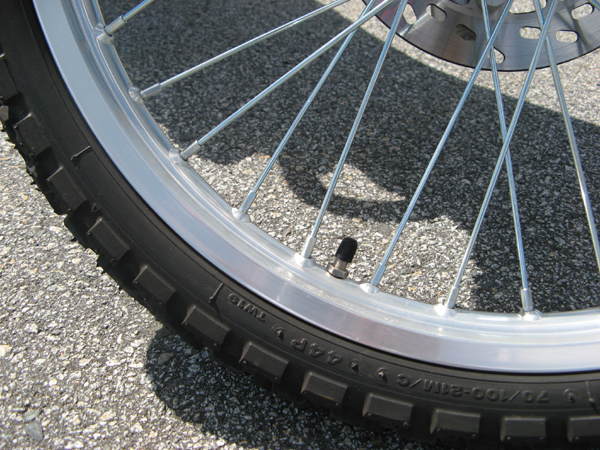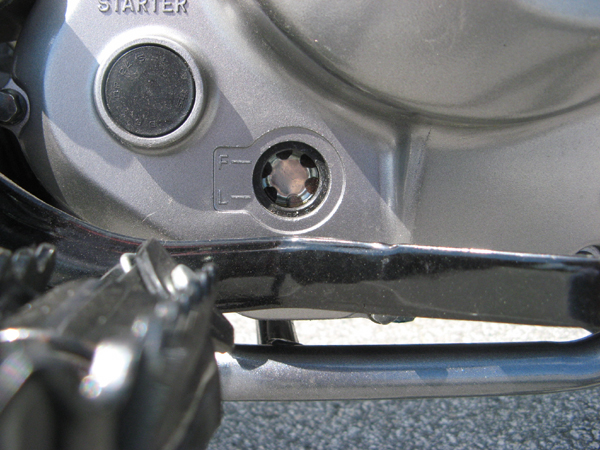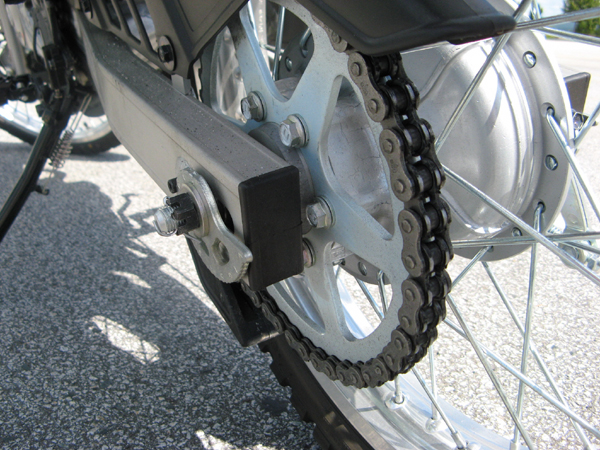The only way to be sure your motorcycle is road ready is by performing a pre-ride inspection before every ride. It only takes a few minutes to look things over and check things out. A pre-ride inspection should become as automatic as watching the weather forecast or grabbing your gear. Those few minutes spent before you get on the road can help ensure a trouble-free ride and enable you to identify potential maintenance problems before they become hazardous. To help you remember what components to check on your bike, Motorcycle Safety Foundation developed the acronym TCLOCS.
T – Tires and Wheels
C – Controls
L – Lights and Electric
O – Oil, Gas and other Fluids
C – Chassis
S – Side Stand
T – Tires and Wheels
The most common cause of tire failure is low tire pressure. Your tires can lose pressure just sitting around. And as Michelin likes to point out in their advertisements, “Theres a lot riding on your tires!” So make it a point to check your tire pressure. Recommended tire pressure can be found right on the frame, and should be adjusted for passengers, heavy loads and off road riding. Tires should always be checked cold. Also look for worn or cracked tread, bulges and embedded objects. Examine the wheels for bent spokes and rims, too.


C – Controls
All the major controls should be checked before every ride. Start with the throttle. Make sure it moves freely and snaps back when released. Squeeze and release both levers – the clutch and the front brake making sure they work. Also check the rear brake pedal and shift lever. Then inspect all cables and hoses, checking for frays, cracks, sharp angles and interference at the steering head.
L – Lights and Electric
Make sure your high and low beams work. Test your turn signals and examine your taillight. Next, verify the operation of the brake light. If you cant see your brake light while youre seated on the motorcycle, use the reflection you can create in a window or garage door to check that your brakes illuminate your brake light. And dont forget to look for cracks and secure connections in all your wiring.

O – Oil, Gas and Other Fluids
Engine oil should always be checked warm. You might have a dipstick, although a sight glass is more common. If the bike has a center stand, it should be up on it when you check the oil. At minimum, the bike should be standing up on level ground when you look into the sight glass. It can be nearly impossible to do this on your own with some bikes, and it might help to have a friend look at the engine oil indicator while you stay seated on the bike or vice versa. (This is not required for Harley-Davidson models. You can check the oil accurately with the dipstick while the bike is on the side stand.)

Youll also want to become familiar with the location of all your other fluids. Depending on your bike, there may be brake, transmission and coolant fluids. Check the level of coolant only when the bike is cool. Look for fluid leaks around gaskets, hoses and seals, and on the garage floor, of course. And don’t forget to make sure you have plenty of fuel.
Chassis
Examine the frame, suspension, drive system and all fasteners. Having a center stand will make it easier to check for play in the swing arm and steering head. Make sure the chain is lubricated and operating under proper tension. If you have a belt drive, no lubrication is necessary, but do check for cracks. Test for adequate play and smooth travel in the front and rear shocks. Fasteners and clips may fall off or crack over time, so check these often.

Stands
You can download the MSF T-CLOCS Checklist here to use before each and every ride. Consult your owners manual for specific information regarding the items on this list. Take few minutes off the clock before you ride to run through TCLOCS. It’s an investment of time that really pays off.
Susan Rzepka Orion is a certified MSF RiderCoach and Rider’s Edge Instructor who loves to ride, write, and help others who want to do the same. You can find her on the road on her BMW F 650 GS or on the Web at WritingWays.com.

To Rose (10/17/08):
You should definitely take the course. After riding on the back of my husband's Harley for a year I decided to take the Rider's Edge course last month to see if I was comfortable on a bike and if I could handle riding myself. The Rider's Edge course I took through a Harley dealership was five days (three evenings in the classroom and two full days on the range). I loved it and got my license the next day and bought my own bike a week later. The course is great and very worthwhile!
My husband keeps suggesting that I learn to ride my own bike, a Yamaha V Star. While I am a bit overwhelmed at riding myself, I would love to know how just in case we are stranded somewhere-or he gets hurt, etc.
Right now, all I do is jump on the back of his bike — a Honda Gold Wing, and ride! How do I begin? I would love to do this and surprise him. How long does it take, a course?
Check out our Beginner's Guide section on WRN. It walks you through all the steps to learning to ride. We also have an article on Choosing Your First Bike in the archives of the Riding Right section that will help. Plus, visit the Readers' Letters to check out the inspirational letters.